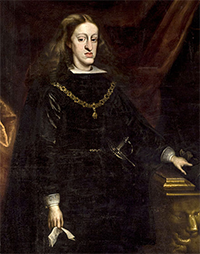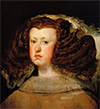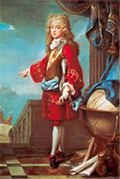King Charles II of Spain
Charles II was King of Spain for 35 years in the 17th Century. His reign was notable for his country's wars with other European powers and much moreso for those powers' struggle to approve of his successor. 
Charles was born on Nov. 16, 1661, at the royal palace in Madrid, the Spanish capital. His father was the reigning monarch, King Philip IV, and his mother was Mariana of Austria. Philip the king died when Charles was 4, and his mother served as regent and ruler. The young king survived a number of maladies that usually proved fatal, including chicken pox, measles, rubella, and smallpox. All of that illness left him physically weak at times and interfered with his early education. More fundamentally, he was born with a deformed jaw and had trouble eating and speaking. He also had trouble walking. 
As Charles was growing up, his mother (right) and half-brother oversaw the prosecution of wars with Portugal, which Philip II had absorbed in 1581 and which had revolted in 1640; with France, a familiar foe; and with other European powers. All of that conflict put a strain on the royal coffers, and it was not uncommon for the crown to declare bankruptcy. Charles's half-brother John initiated an overthrow of Queen Regent Mariana in 1677 and ruled Spain, officially on Charles's behalf. John's rule lasted just two years because he died under mysterious circumstances. Charles's mother again served as regent, overseeing things until her death, in 1696. When Charles was 18, he married 17-year-old Marie Louise of Orléans, a French princess. She died 10 years later, and then Charles married Maria Anna of Neuburg. Neither marriage produced a child, and so Charles had no direct heir to his throne. Spanish tradition allowed the passage of the crown to a woman or the descendant of a woman, and so Charles's sisters, Maria Theresa and Margaret Theresa, could rightly claim that their children were in line to take the Spanish throne. Maria Theresa's husband was France's King Louis XIV, a descendant of the Bourbon line; Margaret Theresa was married to Leopold I, the Holy Roman Emperor and a member of the Habsburg line. Maria Antonia, the daughter of Margaret Theresa and Leopold, had a son named Joseph Ferdinand. He was 6 in 1698 when he was named in Charles II's will as his heir and successor. 
In that same year, France, Great Britain, and the Dutch Republic tried to impose on Spain a partition of its territory. By the terms of the Treaty of the Hague, young Joseph Ferdinand (right) would still be in control of most of Spanish territory; however, hewing closer to its alternate name, the First Partition Treaty, the agreement would have also handed over the Kingdoms of Naples and Sicily to Louis XIV and France. Rejecting what turned out to a forced diplomatic division of territory, Charles published his will. Just a year later, young Joseph Ferdinand died of smallpox. The Spanish king was still holding on to whatever health he had left, still determined not to hand over his empire to anyone except his handpicked successor. In 1700, in response to yet another proposed partition, he named as his successor Archduke Charles, son of Leopold I. 
The final change in this arrangement came late in 1700, when Charles II was in full decline. He changed his will one last time, naming as his successor Philip of Anjou, the grandson of Louis XIV. This was the will that was in place on Nov. 1, 1700, when Charles II died. The new king was Philip V.poiu As it happened, the French king had other ideas. The result was the War of the Spanish Succession. |
|
Social Studies for Kids
copyright 2002–2025
David White




